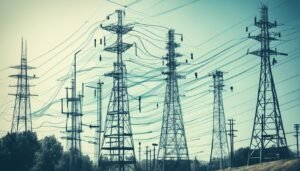Disclosure: This Post Contains Affiliate Links; We earn a commission on purchases.
Electromagnetic fields (EMF) are a common presence in our environment, generated by both natural and human-made sources. These fields include electric fields generated during thunderstorms and the Earth’s magnetic field, as well as human-made sources such as power sockets, TV antennas, and mobile phone base stations. With the advent of modern technology, the number of EMF sources has increased, leading to concerns about potential exposure levels and their impact on our health.
Exposure to EMF is a part of our everyday lives, with everyone being exposed to a mix of electric and magnetic fields from various sources. While low-frequency electric and magnetic fields have the potential to influence the body’s charged particles and electrical currents, research suggests that the levels of induced currents are typically below the thresholds for producing adverse health effects.
However, it’s important to understand the potential risks associated with EMF exposure and take necessary safety measures to protect ourselves and our loved ones.
Key Takeaways:
- The impact of modern technology has led to an increase in the number of EMF sources in our environment.
- EMF exposure is a common occurrence, but the levels of induced currents are typically below the thresholds for producing adverse health effects.
- Further research is needed to fully understand the long-term effects of low-level EMF exposure.
- Regulatory bodies have established guidelines to limit exposure and ensure public safety.
- Individuals can take precautionary measures to reduce their exposure, such as maintaining distance from EMF sources and using EMF protection devices.
Potential Health Risks Associated with EMF Exposure
Research on the potential health effects of EMF exposure has been ongoing, with the World Health Organization (WHO) taking a leading role in studying the biological effects and medical applications of non-ionizing radiation, including EMF. Through its International EMF Project launched in 1996, the WHO has conducted extensive reviews of scientific literature to better understand the impact of EMF on human health.
Based on these reviews, the WHO has concluded that there is currently no evidence confirming the existence of health consequences from exposure to low-level electromagnetic fields. However, it is important to acknowledge that knowledge gaps remain, and further research is necessary to fully comprehend the biological effects of long-term low-level exposure.
Despite the lack of conclusive evidence, concerns about potential health effects related to EMF exposure have been raised by the public. Reported symptoms include headaches, anxiety, fatigue, and even loss of libido. However, it is essential to emphasize that scientific evidence does not support a direct link between these symptoms and EMF exposure.
“There is currently no evidence confirming the existence of health consequences from exposure to low-level electromagnetic fields.”
To address public concerns and ensure public safety, regulatory bodies have established guidelines to limit exposure to EMF from various sources. These guidelines take into account the latest research findings and aim to provide a framework for EMF regulation that minimizes potential risks.
- Research organizations, such as the National Institute of Environmental Health Sciences (NIEHS) in the United States, continue to invest in scientific studies to better understand the potential health impacts of EMF exposure.
- Government agencies, such as the Federal Communications Commission (FCC) in the United States, enforce guidelines to limit EMF exposure from devices, including mobile phones and wireless technologies.
- Intergovernmental organizations, like the International Commission on Non-Ionizing Radiation Protection (ICNIRP), regularly review and update exposure guidelines to ensure the adequacy of protection measures.
By staying informed and aware of the latest research and regulatory guidelines, individuals can make informed decisions regarding their exposure to EMF. Public awareness campaigns can also contribute to educating the general public about the potential risks of EMF exposure and the importance of following recommended safety measures.
| Regulatory Body | Country/Region | Guidelines |
|---|---|---|
| Federal Communications Commission (FCC) | United States | Guidelines for radiofrequency electromagnetic exposure |
| International Commission on Non-Ionizing Radiation Protection (ICNIRP) | International | Guidelines on limiting exposure to electromagnetic fields |
| National Institute for Occupational Safety and Health (NIOSH) | United States | Recommended exposure limits for occupational EMF exposure |
It is important to note that while guidelines exist to regulate EMF exposure, the effectiveness of preventive measures may vary. Individuals should prioritize reputable products and consult with professionals when considering the use of EMF protection devices.
The Need for Continued EMF Research
As technology continues to evolve, and the number of EMF sources increases, ongoing research is vital to better understand the potential long-term effects of exposure. Advanced studies are necessary to fill existing knowledge gaps and provide more comprehensive insights into the impact of EMF on human health. By investing in further research, we can enhance the safety measures and regulations surrounding EMF exposure and ensure the well-being of individuals in an increasingly interconnected world.
Safety Measures and Mitigation Strategies for EMF Protection
To protect individuals from potential EMF exposure, it is important to implement safety measures and mitigation strategies. By taking proactive steps, you can reduce your exposure to electromagnetic fields and promote a safer living environment.
Maintaining a Distance from EMF Sources
One of the simplest and most effective safety measures is to maintain a distance from EMF sources. By keeping a safe distance, you can limit your exposure to electromagnetic radiation. For example, when using electronic devices, try to keep them at arm’s length to minimize direct contact.
Limiting the Use of Mobile Devices
Mobile devices, such as smartphones and tablets, emit electromagnetic radiation. To reduce your exposure, consider limiting the time you spend using these devices. Set boundaries for yourself and your family members to ensure a healthy balance between screen time and other activities.
Using Hands-Free Options
When making calls on your mobile phone, consider using hands-free options such as speakerphone or headphones. This helps to keep the device away from your body and minimize direct exposure to electromagnetic radiation.
EMF Protection Devices

There are also various EMF protection devices available in the market. These devices work by reducing the intensity of EMF or blocking EMF radiation altogether. Here are some examples of EMF protection devices:
- EMF Shields for Mobile Phones: These shields are designed to reduce the amount of electromagnetic radiation emitted by your mobile phone. They can be applied directly to the back of your device.
- EMF-Blocking Fabrics for Clothing: These fabrics are specially designed to block or absorb electromagnetic radiation. They can be used to line pockets or as clothing accessories.
- EMF Shielding Paint for Walls: This type of paint contains materials that help block or reduce the penetration of electromagnetic radiation through walls. It can be applied to the interior walls of your home or office.
Please note that the effectiveness of these devices can vary, and it is important to research and choose products from reputable manufacturers. Additionally, it is crucial to remember that EMF protection devices should be used in conjunction with other safety measures for optimal protection.
The Evolution of EMF Exposure in the Modern Era
The evolution of modern technology has had a significant impact on the levels of electromagnetic fields (EMF) in our environment. With the deployment of wireless technologies such as mobile phone networks and Wi-Fi, the number of EMF sources has increased exponentially. This proliferation of EMF sources has raised concerns about the potential health risks associated with long-term exposure to EMF radiation.
One of the latest technological advancements that has sparked discussions about EMF exposure is the advent of 5G technology. 5G networks utilize higher frequency bands, which has led to concerns about increased EMF radiation exposure. However, it is important to note that EMF levels can fluctuate over time and are not explicitly decreasing or increasing as new technologies emerge.
To ensure the safety of the general public, regulatory bodies have established guidelines to regulate EMF exposure. These guidelines are regularly reviewed and updated to align with the latest scientific research and advancements in technology. The aim is to strike a balance between the benefits of modern technology and the potential risks associated with EMF exposure.
In addition to regulatory efforts, there has been a growing awareness about the potential health effects of EMF exposure. The public’s increasing awareness has resulted in a demand for more research on the subject. Monitoring networks have been established to assess and track environmental EMF levels, providing valuable data for further study and analysis.
Overall, the evolution of modern technology has brought about changes in the levels of EMF exposure in our environment. Regulatory measures, ongoing research, and public awareness play crucial roles in ensuring that the impact of modern technology on EMF levels is carefully monitored and managed for the well-being of individuals and society as a whole.
| Impact of Modern Technology on EMF | EMF Regulation | EMF Awareness |
|---|---|---|
| Increased number of EMF sources | Establishment of regulatory guidelines | Public demand for research |
| Deployment of wireless technologies | Regular review and update of guidelines | Monitoring networks to track EMF levels |
| Advent of 5G technology and concerns about EMF radiation | Ongoing research and analysis | Growing awareness of potential health effects |

Conclusion
The impact of modern technology on EMF levels in our environment is a topic of ongoing research and discussion. While there is currently no evidence confirming adverse health effects from low-level EMF exposure, it is important to continue research and monitoring to further understand the potential long-term effects. Regulatory bodies play a crucial role in establishing guidelines and regulations to limit exposure, ensuring public safety, and mitigating the potential risks associated with EMF.
Individuals can also take their own precautionary measures to minimize their exposure. Maintaining a distance from EMF sources, such as power sockets and mobile devices, can reduce personal exposure levels. Additionally, using EMF protection devices, such as shielding technologies and accessories, can provide an extra layer of protection. These devices work by reducing the intensity of EMF or blocking EMF radiation altogether.
As technology continues to evolve and our reliance on electronic devices grows, it is important for individuals to stay informed and aware of the potential risks associated with EMF exposure. Ongoing research, along with updated regulations and guidelines, will help ensure that individuals are equipped with the necessary knowledge and tools to mitigate the potential health effects of EMF exposure in our modern world.
Source Links
- https://www.who.int/news-room/questions-and-answers/item/radiation-electromagnetic-fields
- https://www.nature.com/articles/s41598-023-41034-3
- https://www.ncbi.nlm.nih.gov/pmc/articles/PMC6025786/

Subscribe to Our Newsletter










